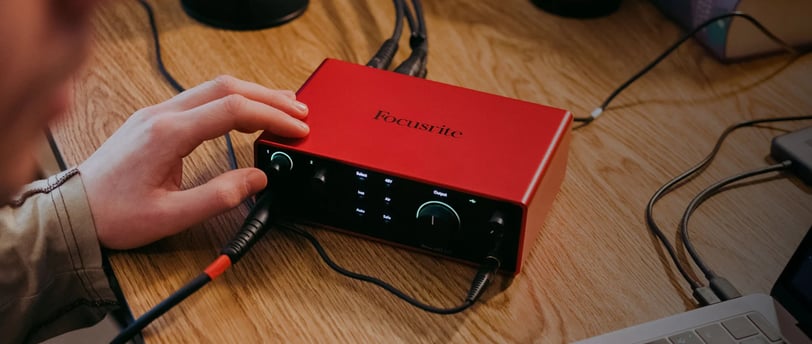Best Audio Interfaces with a $200 Budget
6/23/20253 min read


First of all what is an Audio Interface?
An audio interface is a device that connects your microphone, instruments, and other audio gear to your computer, allowing you to record high-quality sound and play it back with low latency.
It acts as a bridge between your gear and your DAW (digital audio workstation).
What Does It Do?
Here’s what an audio interface does:
Converts analog sound to digital so your computer can understand and record it (this is called A/D conversion).
Converts digital audio to analog so you can hear it through headphones or speakers (this is D/A conversion).
Improves sound quality compared to your computer’s built-in sound card.
Provides inputs (for microphones, instruments, etc.) and outputs (for monitors, headphones, etc.).
Lets you record multiple sources at once (like vocals and guitar).
Three key quality criteria :
1. Preamps Quality
Why it matters: The preamps amplify your mic/instrument signal before it’s recorded. High-quality preamps give you clean, clear sound with minimal noise.
What to look for: Low noise floor, transparent sound, and enough gain (especially important for dynamic mics like the Shure SM7B).
Tip: Look for interfaces with a good reputation for preamp quality, like Focusrite or Universal Audio.
2. Low Latency Performance
Why it matters: Latency is the delay between when you play or sing and when you hear it back. High latency can be distracting or unusable for real-time recording or monitoring.
What to look for: Low round-trip latency (usually under 10ms is great), especially when tracking with effects.
Tip: Interfaces with solid drivers and direct monitoring options help reduce latency issues.
3. Good A/D and D/A Conversion
Why it matters: These converters determine how accurately your interface translates sound from analog to digital and back again. Poor conversion = loss of detail, clarity, and stereo image.
What to look for: High-resolution support (at least 24-bit/48kHz), and good dynamic range (higher dB is better).
Tip: Interfaces with converters from brands like Apogee or RME often stand out, but even many budget models today do a solid job.
My personal selection :
N°1 : Focusrite Scarlett 2i2
✅ High-Quality Preamps
Focusrite’s award-winning preamps deliver clean, transparent sound with low noise.
Great for vocals, instruments, and even lower-output mics.
The newer 3rd Gen model includes an “Air” mode that adds a bit of brightness and presence—nice for vocals.
✅ Plug-and-Play Simplicity
Super easy to set up—just plug it in via USB and you’re good to go.
Compatible with Windows, macOS, and works well with all major DAWs (Ableton, FL, Logic, etc.).
Ideal for beginners who want a smooth start without a complicated setup.
✅ Reliable Low-Latency Monitoring
Direct monitoring switch lets you hear your input signal in real time, with no delay.
Great for recording vocals or instruments without any annoying lag.
USB-C connection on newer versions ensures stable performance and faster data transfer.
N°2 : PreSonus AudioBox USB
✅ Great Value for the Price
The AudioBox USB is very affordable, making it ideal for beginners or anyone on a tight budget.
You get two combo inputs (mic/instrument), phantom power, MIDI I/O, and solid build quality—all at a low cost.
Excellent entry-level option for singer-songwriters or podcasters.
✅ Includes Studio One DAW Software
Comes with Studio One Artist, a full-featured digital audio workstation.
You can start recording, editing, and mixing right out of the box without buying additional software.
Great for beginners who don’t already have a DAW.
✅ Built-In MIDI I/O
Unlike many entry-level interfaces, the AudioBox USB includes dedicated MIDI In and Out ports.
This is super useful if you want to connect external MIDI gear like keyboards, drum machines, or synths.
Saves you from needing a separate MIDI interface—great for producers who want to expand their setup later on.
N°3 : Behringer UMC22
✅ Midas-Designed Mic Preamp
Comes with a Midas preamp, which is surprisingly good for this price range.
Offers clean and clear mic recordings with decent headroom—great for vocals or podcasting.
✅ Simple and Easy to Use
Straightforward layout: one mic input, one instrument input, headphone output, and volume knobs.
Plug-and-play functionality—works with most DAWs and operating systems without hassle.
Ideal for users who just want to plug in and start recording without a learning curve.
✅ Solid Metal Build
Despite the low cost, the UMC22 has a sturdy metal chassis that feels reliable and durable.
Great for portable setups or everyday home studio use without worrying about it breaking easily.
N°4 : Universal Audio Volt 2
✅ Studio-Grade Sound Quality & Vintage Tube Mode
With 24‑bit/192 kHz conversion, ultra‑low noise preamps (about ‑127 dBu EIN), and a Vintage mode emulating UA’s iconic 610 tube preamp, the Volt 2 delivers rich, warm, and detailed recordings—no small feat under $200.
✅ Zero-Latency Direct Monitoring & Flexible Connectivity
Thanks to direct monitoring with mono/stereo toggle and USB‑C (plus optional 5V power), you can easily record on Mac, PC, iPad, or iPhone with pristine sound and no delay.
✅ Excellent Software Bundle & Long-Term Value
It comes with a premium software package—Ableton Live Lite, Melodyne Essential, UJAM instruments, Softube amps, and more—offering a powerful start without extra purchases, making it a smart long-term investment.